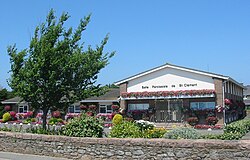Saint Clement, Jersey
| Saint Clement Jèrriais: St Cliément | |
| Jersey | |
|---|---|
 The Parish Hall of St Clement at Le Hocq | |
| Area: | 1,044 acres |
| Population: | 9221 2011 |
| Island: | Jersey |
Saint Clement is one of the twelve parishes of Jersey. It lies in the southeast of the island, and contains some of the suburbs of St Helier. It is the smallest of Jersey's parishes by surface area, with just 1,044 acres, but it is the second most densely populated.
St Clement stretches west to east from Le Dicq to within a quarter mile of La Rocque harbour (at the end of Rue de la Lourderie).
History

Much of the parish lies below equinoctial high-tide level and was frequently flooded before Le Dicq was built to try to hold back the sea somewhat. There are remains of a submerged forest underneath the sand at Grève d'Azette that show how the parish has reduced in size as the sea has advanced. Large floods in 1688, 1796 and 1812 led to the coast road at Le Hocq being swept away by the sea and necessitated the coast road being rebuilt further inland.
In pre-Norman times, the area now known as St Clement was known as Petravilla or Pierreville. In 1172 it was recorded that a chapel existed in the parish, and there was a priory on the site of the old Priory Inn (now houses).
In the 16th and 17th centuries the parish was believed to be the centre of a witch movement. According to beliefs, the rock at Rocque Berg (known as the Witches' Rock) was the focus for witchcraft in Jersey, where witches would assemble for their black rites.
After the revocation of the Edict of Nantes in 1685, many French Protestants settled in the parish – as recorded on the church register.
In the mid 19th century, the town began to spread east from St Helier into the west of the parish. Today there is relatively little open green space (with the exception of the golf and football fields) west of Samarès Lane into St Helier.
The famous French writer Victor Hugo lived in Marina Terrace, St Clement for some time, and it was here that he wrote his collection of poems entitled Les Châtiments. It was the Connétable of St Clement at the time who escorted Hugo onto a steamer bound for Guernsey when he had insulted the British Royal Family in some of his letters.[1]
Vingtaines
The parish is divided into three vingtaines:
Schools
St Clement has two primary schools and one secondary school within its borders. The parish school of St Clement is located in Rue de la Chapelle, and dates back to 1901. It has been replaced in 2006 with a brand new building on the opposite side of the road.
Samarès School (formerly Le Squez School) is another primary school located further east in School Road, Le Squez.
Le Rocquier secondary school is located next to St Clement's parish school, and was also replaced with a new building in 2006.
Churches

The parish church of St Clement[2] is an ancient place of Anglican worship located on La Grande Route de St Clément (St Clement's inner road).
St Nicholas is a smaller, sister church, located on La Grande Route de la Côte (the coast road). It was opened in 1927 after being planned, financed and largely built by the Reverend L.B. Lee.
The Samarès Methodist Church[3] is located on La Grande Route de la Côte. It is the southernmost church in the British Isles [4]]]
The St Patrick's Roman Catholic Church is located on La Grande Route de St Clément at Samarès.
Sites of the parish

The dolmen at Mont Ubé (off La Blinerie) is believed to have been left there by pre-Celtic folk around 3,000 BC.
Remains of a cemetery on La Motte (Green Island) are believed to be from later settlers. [1] A Neolithic cairn and middens on La Motte have also been investigated.
Le Hocq Tower was built in 1778 as a coastal defence against the French when they sided with the American colonies against the British.
The whole rocky inter-tidal zone that stretches along St Clement's coast from St. Saviour to Grouville is part of a Ramsar site of special significance.
Seymour Tower sits two miles offshore on one of the largest inter-tidal reefs in the world. Built as part of Jersey’s costal defences, this square tower dates from the 18th century. The isolated location means access is dependent on tidal conditions and all guests must be accompanied by an accredited Seymour Tower guide. Seymour Tower is only available to rent when the tide allows safe and manageable access on foot[5]
Outside links
- St Clement Official Parish website
- St Cliément at Les Pages Jèrriaises
- St Clement's Church
- Samares Methodist Church
- St Clement's School
- Samares School
- Le Rocquier School
References
- Balleine, G.R., 1970. The Bailiwick of Jersey (Revised by Joan Stevens). ISBN 0340002670
| Parishes of Jersey |
|---|
|
St Brelade • St Clement • Grouville • St Helier • St John • St Lawrence • St Martin • St Mary • St Ouen • St Peter • St Saviour • Trinity |